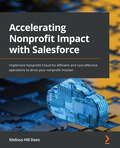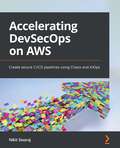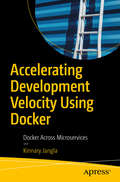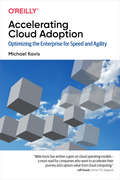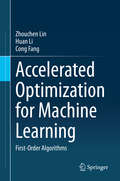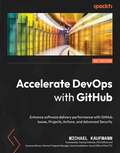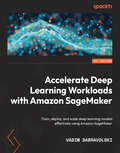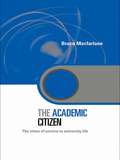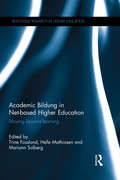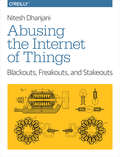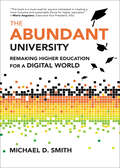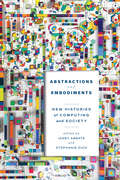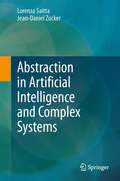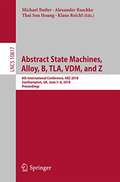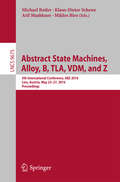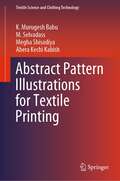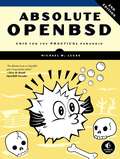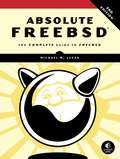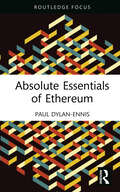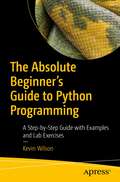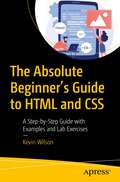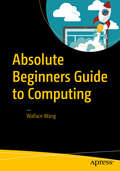- Table View
- List View
Accelerating Nonprofit Impact with Salesforce: Implement Nonprofit Cloud for efficient and cost-effective operations to drive your nonprofit mission
by Melissa Hill DeesDrive digital transformation for nonprofits with well-organized volunteer management, donor engagement, fundraising, and grantmaking using the intelligent and powerful capabilities of Salesforce Nonprofit CloudKey FeaturesImplement NPSP modules to scale varied business operations in nonprofitsAdminister and automate business processes and tasks with NPSP for nonprofitsCustomize and extend the standard functionalities of Nonprofit Cloud and NPSP as per client needs, resources, and critical outcomesBook DescriptionSalesforce Nonprofit Cloud enables a 360-degree view of people related to your nonprofit to connect fundraising, program management, and grantmaking. With a single, unified view of every interaction with constituents, nonprofits can create strong relationships with the community and streamline internal processes. The book starts by covering the tools and features that make up Nonprofit Cloud, helping you understand their standard functionalities and how Nonprofit Success Pack's (NPSP) data architecture is critical to implementation. You'll learn how the Nonprofit Cloud Program Management Module can connect your programs, automate case management, and track client progress. Next, you'll explore the tools for creating a change management process to increase user adoption. Moving ahead, you'll understand how to configure necessary permissions for NPSP administration and explore how declarative tools help better align the goals of a nonprofit organization. Toward the concluding chapters, you'll cover customizations, deployment, custom reports, and dashboards for fundraising analytics, as well as best practices for data management to maintain its integrity. By the end of this Salesforce book, you'll be able to build and configure the Nonprofit Cloud for a variety of use cases to achieve maximum social impact with the least amount of technical debt.What you will learnImplement various components and modules in Nonprofit CloudImplement tools for grantmaking, program management, and case managementExtend the standard functionalities of Nonprofit Cloud and NPSPIdentify and use success metrics to prioritize goals and outcomes for implementationExplore the tools that Nonprofit Cloud offers for testing and deploymentBuild custom reports and dashboards for NPSP and use Tableau dashboard starters for fundraising analyticsUnderstand best practices for data management to maintain data accuracy and data integrityWho this book is forThis book is for technical consultants, functional consultants, and Salesforce architects who are working with nonprofit organizations and want to implement different functionalities within Nonprofit Cloud and NPSP optimally for business processes and tasks in their organizations. Salesforce administrator skills and overall proficiency with Salesforce are required to get the most out of this book.
Accelerating DevSecOps on AWS: Create secure CI/CD pipelines using Chaos and AIOps
by Nikit SwarajBuild high-performance CI/CD pipelines that are powered by AWS and the most cutting-edge tools and techniquesKey FeaturesMaster the full AWS developer toolchain for building high-performance, resilient, and powerful CI/CD pipelinesGet to grips with Chaos engineering, DevSecOps, and AIOps as applied to CI/CDEmploy the latest tools and techniques to build a CI/CD pipeline for application and infrastructureBook DescriptionContinuous integration and continuous delivery (CI/CD) has never been simple, but these days the landscape is more bewildering than ever; its terrain riddled with blind alleys and pitfalls that seem almost designed to trap the less-experienced developer. If you're determined enough to keep your balance on the cutting edge, this book will help you navigate the landscape with ease. This book will guide you through the most modern ways of building CI/CD pipelines with AWS, taking you step-by-step from the basics right through to the most advanced topics in this domain.The book starts by covering the basics of CI/CD with AWS. Once you're well-versed with tools such as AWS Codestar, Proton, CodeGuru, App Mesh, SecurityHub, and CloudFormation, you'll focus on chaos engineering, the latest trend in testing the fault tolerance of your system. Next, you'll explore the advanced concepts of AIOps and DevSecOps, two highly sought-after skill sets for securing and optimizing your CI/CD systems. All along, you'll cover the full range of AWS CI/CD features, gaining real-world expertise.By the end of this AWS book, you'll have the confidence you need to create resilient, secure, and performant CI/CD pipelines using the best techniques and technologies that AWS has to offer.What you will learnUse AWS Codestar to design and implement a full branching strategyEnforce Policy as Code using CloudFormation Guard and HashiCorp SentinelMaster app and infrastructure deployment at scale using AWS Proton and review app code using CodeGuruDeploy and manage production-grade clusters using AWS EKS, App Mesh, and X-RayHarness AWS Fault Injection Simulator to test the resiliency of your appWield the full arsenal of AWS Security Hub and Systems Manager for infrastructure security automationEnhance CI/CD pipelines with the AI-powered DevOps Guru serviceWho this book is forThis book is for DevOps engineers, engineering managers, cloud developers, and cloud architects. Basic experience with the software development life cycle, DevOps, and AWS is all you need to get started.
Accelerating Development Velocity Using Docker: Docker Across Microservices
by Kinnary JanglaDiscover how a software engineer can leverage Docker in order to expedite development velocity. This book focuses on the fundamental concepts this program is built upon and explores how it can help you get your services up and running inside Docker containers. You'll also review tips on how to debug microservices applications that run inside Docker containers.Tech companies are now developing complex softwares that are comprised of multiple services running on different platforms, and Docker has become an essential part of coordinating the communication between these services and platforms. This book addresses problems caused by drifting microservices, debugging across services, inconsistent environments across machines, and coordinating development of machine learning systems between a team of developers, etc. Accelerating Development Velocity Using Docker puts you on the path to transforming your complex systems into more efficient ones.What You'll LearnSetup Docker and employ quick solutions to road blocksReview challenges associated with debugging microservices that sit behind a complex applicationLeverage Docker features to seamlessly get multiple microservices up and runningDebug inside a Docker containerReview advanced use cases of Docker that can help consistency of development environments· Who This Book Is ForIdeal for new to mid-level infrastructure engineers who want to learn how to make their development environments efficient across their and cross teams, or for students who aspire to learn basics of how to debug distributed systems and how to develop efficient applications.
Accelerating Cloud Adoption
by Michael KavisMany companies move workloads to the cloud only to encounter issues with legacy processes and organizational structures. How do you design new operating models for this environment? This practical book shows IT managers, CIOs, and CTOs how to address the hardest part of any cloud transformation: the people and the processes.Author Mike Kavis (Architecting the Cloud) explores lessons learned from enterprises in the midst of cloud transformations. Youâ??ll learn how to rethink your approach from a technology, process, and organizational standpoint to realize the promise of cost optimization, agility, and innovation that public cloud platforms provide.Learn the difference between working in a data center and operating in the cloudExplore patterns and anti-patterns for organizing cloud operating modelsGet best practices for making the organizational change required for a move to the cloudUnderstand why site reliability engineering is essential for cloud operationsImprove organizational performance through value stream mapping
Accelerated Optimization for Machine Learning: First-Order Algorithms
by Zhouchen Lin Huan Li Cong FangThis book on optimization includes forewords by Michael I. Jordan, Zongben Xu and Zhi-Quan Luo. Machine learning relies heavily on optimization to solve problems with its learning models, and first-order optimization algorithms are the mainstream approaches. The acceleration of first-order optimization algorithms is crucial for the efficiency of machine learning. Written by leading experts in the field, this book provides a comprehensive introduction to, and state-of-the-art review of accelerated first-order optimization algorithms for machine learning. It discusses a variety of methods, including deterministic and stochastic algorithms, where the algorithms can be synchronous or asynchronous, for unconstrained and constrained problems, which can be convex or non-convex. Offering a rich blend of ideas, theories and proofs, the book is up-to-date and self-contained. It is an excellent reference resource for users who are seeking faster optimization algorithms, as well as for graduate students and researchers wanting to grasp the frontiers of optimization in machine learning in a short time.
Accelerate DevOps with GitHub: Enhance software delivery performance with GitHub Issues, Projects, Actions, and Advanced Security
by Michael Kaufmann Thomas Dohmke Donovan BrownTake your DevOps and DevSecOps game to the next level by leveraging the power of the GitHub toolset in practiceKey FeaturesRelease software faster and with confidenceIncrease your productivity by spending more time on software delivery and less on fixing bugs and administrative tasksDeliver high-quality software that is more stable, scalable, and secureBook DescriptionThis practical guide to DevOps uses GitHub as the DevOps platform and shows how you can leverage the power of GitHub for collaboration, lean management, and secure and fast software delivery. The chapters provide simple solutions to common problems, thereby helping teams that are already on their DevOps journey to further advance into DevOps and speed up their software delivery performance. From finding the right metrics to measure your success to learning from other teams' success stories without merely copying what they've done, this book has it all in one place. As you advance, you'll find out how you can leverage the power of GitHub to accelerate your value delivery – by making work visible with GitHub Projects, measuring the right metrics with GitHub Insights, using solid and proven engineering practices with GitHub Actions and Advanced Security, and moving to event-based and loosely coupled software architecture. By the end of this GitHub book, you'll have understood what factors influence software delivery performance and how you can measure your capabilities, thus realizing where you stand in your journey and how you can move forward.What you will learnEffectively measure software delivery performanceAdopt DevOps and lean management techniques in your teamsPlan, track, and visualize your work using GitHub Issues and ProjectsUse continuous delivery with GitHub Actions and PackagesScale quality through testing in production and chaos engineering“Shift left” security and secure your entire software supply chainUse DevSecOps practices with GitHub Advanced SecuritySecure your code with code scanning, secret scanning, and DependabotWho this book is forThis book is for developers, solutions architects, DevOps engineers, and SREs, as well as for engineering or product managers who want to enhance their software delivery performance. Whether you're new to DevOps, already have experience with GitHub Enterprise, or come from a platform such as Azure DevOps, Team Foundation Server, GitLab, Bitbucket, Puppet, Chef, or Jenkins but struggle to achieve maximum performance, you'll find this book beneficial.
Accelerate Deep Learning Workloads with Amazon SageMaker: Train, deploy, and scale deep learning models effectively using Amazon SageMaker
by Vadim DabravolskiPlan and design model serving infrastructure to run and troubleshoot distributed deep learning training jobs for improved model performance.Key FeaturesExplore key Amazon SageMaker capabilities in the context of deep learningTrain and deploy deep learning models using SageMaker managed capabilities and optimize your deep learning workloadsCover in detail the theoretical and practical aspects of training and hosting your deep learning models on Amazon SageMakerBook DescriptionOver the past 10 years, deep learning has grown from being an academic research field to seeing wide-scale adoption across multiple industries. Deep learning models demonstrate excellent results on a wide range of practical tasks, underpinning emerging fields such as virtual assistants, autonomous driving, and robotics. In this book, you will learn about the practical aspects of designing, building, and optimizing deep learning workloads on Amazon SageMaker. The book also provides end-to-end implementation examples for popular deep-learning tasks, such as computer vision and natural language processing. You will begin by exploring key Amazon SageMaker capabilities in the context of deep learning. Then, you will explore in detail the theoretical and practical aspects of training and hosting your deep learning models on Amazon SageMaker. You will learn how to train and serve deep learning models using popular open-source frameworks and understand the hardware and software options available for you on Amazon SageMaker. The book also covers various optimizations technique to improve the performance and cost characteristics of your deep learning workloads.By the end of this book, you will be fluent in the software and hardware aspects of running deep learning workloads using Amazon SageMaker.What you will learnCover key capabilities of Amazon SageMaker relevant to deep learning workloadsOrganize SageMaker development environmentPrepare and manage datasets for deep learning trainingDesign, debug, and implement the efficient training of deep learning modelsDeploy, monitor, and optimize the serving of DL modelsWho this book is forThis book is relevant for ML engineers who work on deep learning model development and training, and for Solutions Architects who design and optimize end-to-end deep learning workloads. It assumes familiarity with the Python ecosystem, principles of Machine Learning and Deep Learning, and basic knowledge of the AWS cloud.
The Academic Citizen: The Virtue of Service in University Life (Key Issues in Higher Education)
by Bruce MacfarlaneWith increasing focus on excellence in research and teaching, the service role of the individual academic is often neglected. This book calls for greater recognition of this important aspect of academic life, highlighting the importance of mentoring, committee work and pastoral care in the daily running of universities. Drawing from extensive examples from models around the world, The Academic Citizen points to the benefits of effective communication with colleagues in the faculty, across the university and in corresponding faculties across the world, as well as those in maintaining positive associations with the wider world.
Academic Bildung in Net-based Higher Education: Moving beyond learning (Routledge Research in Higher Education)
by Trine Fossland Helle Mathiasen Mariann SolbergThe explosive emergence of net-based learning in higher education brings with it new possibilities and constraints in teaching and learning environments.This edited collection considers how the concept of Academic Bildung - a term suggesting a personal educational process beyond actual educational learning - can be applied to net-based higher education. The book is drawing on Scandinavian research to address the topic from both a theoretical and practical standpoint.Chapters explore the facilitation of online courses and argue how and why universities should involve dimensions of Academic Bildung on both a strategic and technological pedagogical content level. The book is structured in three parts: Part I frames the current state of net-based learning and introduces Bildung as a concept; Part II contains a set of four case studies in Norway, Sweden and Denmark, also including a fifth study that looks at Scandinavian approaches to teaching and learning in comparison with data from the USA, the UK, Australia and Canada; Part III provides a synthesis of theories and cases to examine whether a Scandinavian orientation can be discerned. Contributions suggest that in order to address one of the fundamental functions of higher education, the ability to produce new knowledge, the Academic Bildung of the students has to be in focus. Grounded in theoretical and empirical discussion, this book will appeal to researchers and academics in the field of higher education as well as personnel who work with teaching and learning with technology, and academics interested in the question of Academic Bildung.
Abusing the Internet of Things: Blackouts, Freakouts, and Stakeouts
by Nitesh DhanjaniThe upcoming IoT age will blur the line between our physical and online lives. Attacks targeting our online spaces will put our physical security at risk. Traditionally, the attack vectors to our fundamental luxuries have required physical tampering, mostly because access to the infrastructure has been limited from the Internet. This is about to change with the upcoming disruption caused by a future with billions of "things" connected to the Internet.This book takes a fascinating look into abusing the most popular IoT-based devices already available in the market. You'll learn how a simple attack can cause a perpetual blackout targeting LED lightbulbs, how bad security decisions have grossly violated the physical safety and privacy of families, and how the insecurity of powerful electric vehicles can put your life at risk.The goal of this book is to demonstrate tangible risk in IoT devices that we're going to depend on more and more as time progresses. Once we begin to understand the cause of actual security vulnerabilities in devices today, we will begin to set the path for a future that will help us enable these devices to securely enhance and augment our lives.The stakes are high. Malicious attackers are already hard at work uncovering and exploiting these security defects and they will continue to find crafty avenues to abuse their knowledge every way they can. These attackers span the spectrum of curious college students to sophisticated private and state sponsored criminal gangs that are interested in terrorizing individuals and populations. The impact of security vulnerabilities in IoT devices can lead to mass compromise of privacy and cause physical harm.
Abuse: An Encyclopedia Of Causes, Consequences, And Treatments
by Rosemarie SkaineAbuse, a key theme of health education curricula, is also a major issue faced by many segments of society. Intended for high school students as well as undergraduates and the general reader, this comprehensive encyclopedia explores abuse in all its forms--physical, sexual, emotional, and verbal--among a variety of age and demographic groups from children to the elderly to the disabled. It sheds light on causes and symptoms of abuse, examines lasting impacts, and suggests avenues for prevention and treatment. <P><P> Specific topics of concern to a secondary school audience include bullying and cyberbullying; abuse of those in same-sex relationships; and sexual abuse through rape, date rape, incest, and sexting. Elder abuse, which has become of greater concern as our society ages, is covered, as are domestic abuse, child abuse, and abduction. Through up-to-date entries by expert contributors, readers will learn about the causes and results of specific types of abuse, as well as their legal and sociological dimensions. The title will also serve as a gateway to further study--and as a resource for readers seeking help.
The Abundant University: Remaking Higher Education for a Digital World
by Michael D. SmithWhy our current system of higher education is financially and morally unsustainable and how to address the crisis with the creative implementation of digital technologies.For too long, our system of higher education has been defined by scarcity: scarcity in enrollment, scarcity in instruction, and scarcity in credentials. In addition to failing students professionally, this system has exacerbated social injustice and socioeconomic stratification across the globe. In The Abundant University, Michael D. Smith argues that the only way to create a financially and morally sustainable higher education system is by embracing digital technologies for enrolling, instructing, and credentialing students—the same technologies that we have seen create abundance in access to resources in industry after industry.The Abundant University explains how we got our current system, why it&’s such an expensive, inefficient mess, and how a system based on exclusivity cannot foster inclusivity. Smith challenges the resistance to digital technologies that we have already seen among numerous institutions, citing the examples of faculty resistance toward digital learning platforms. While acknowledging the understandable self-preservation instinct of our current system of residential education, Smith makes a case for how technology can engender greater educational opportunity and create changes that will benefit students, employers, and society as a whole.
Abstractions and Embodiments: New Histories of Computing and Society (Studies in Computing and Culture)
by Janet Abbate and Stephanie DickCutting-edge historians explore ideas, communities, and technologies around modern computing to explore how computers mediate social relations.Computers have been framed both as a mirror for the human mind and as an irreducible other that humanness is defined against, depending on different historical definitions of "humanness." They can serve both liberation and control because some people's freedom has historically been predicated on controlling others. Historians of computing return again and again to these contradictions, as they often reveal deeper structures.Using twin frameworks of abstraction and embodiment, a reformulation of the old mind-body dichotomy, this anthology examines how social relations are enacted in and through computing. The authors examining "Abstraction" revisit central concepts in computing, including "algorithm," "program," "clone," and "risk." In doing so, they demonstrate how the meanings of these terms reflect power relations and social identities. The section on "Embodiments" focuses on sensory aspects of using computers as well as the ways in which gender, race, and other identities have shaped the opportunities and embodied experiences of computer workers and users. Offering a rich and diverse set of studies in new areas, the book explores such disparate themes as disability, the influence of the punk movement, working mothers as technical innovators, and gaming behind the Iron Curtain. Abstractions and Embodiments reimagines computing history by questioning canonical interpretations, foregrounding new actors and contexts, and highlighting neglected aspects of computing as an embodied experience. It makes the profound case that both technology and the body are culturally shaped and that there can be no clear distinction between social, intellectual, and technical aspects of computing. Contributors: Janet Abbate, Marc Aidinoff, Troy Kaighin Astarte, Ekaterina Babinsteva, André Brock, Maarten Bullynck, Jiahui Chan, Gerardo Con Diaz, Liesbeth De Mol, Stephanie Dick, Kelcey Gibbons, Elyse Graham, Michael J. Halvorson, Mar Hicks, Scott Kushner, Xiaochang Li, Zachary Loeb, Lisa Nakamura, Tiffany Nichols, Laine Nooney, Elizabeth Petrick, Cierra Robson, Hallam Stevens, Jaroslav Švelch
Abstraction in Artificial Intelligence and Complex Systems
by Jean-Daniel Zucker Lorenza SaittaAbstraction is a fundamental mechanism underlying both human and artificial perception, representation of knowledge, reasoning and learning. This mechanism plays a crucial role in many disciplines, notably Computer Programming, Natural and Artificial Vision, Complex Systems, Artificial Intelligence and Machine Learning, Art, and Cognitive Sciences. This book first provides the reader with an overview of the notions of abstraction proposed in various disciplines by comparing both commonalities and differences. After discussing the characterizing properties of abstraction, a formal model, the KRA model, is presented to capture them. This model makes the notion of abstraction easily applicable by means of the introduction of a set of abstraction operators and abstraction patterns, reusable across different domains and applications. It is the impact of abstraction in Artificial Intelligence, Complex Systems and Machine Learning which creates the core of the book. A general framework, based on the KRA model, is presented, and its pragmatic power is illustrated with three case studies: Model-based diagnosis, Cartographic Generalization, and learning Hierarchical Hidden Markov Models.
Abstract State Machines, Alloy, B, TLA, VDM, and Z: 5th International Conference, Abz 2016, Linz, Austria, May 23-27, 2016, Proceedings (Lecture Notes in Computer Science #9675)
by Michael Butler Atif Mashkoor Miklos Biro Laus-Dieter ScheweThis book constitutes the refereed proceedings of the 5th International Conference on Abstract State Machines, Alloy, B, TLA, VDM, and Z, ABZ 2016, held in Linz, Austria, in May 2016. <P><P> The 17 full and 15 short papers presented in this volume were carefully reviewed and selected from 61 submissions. They record the latest research developments in state-based formal methods Abstract State Machines, Alloy, B, Circus, Event-B, TLS+, VDM and Z.
Abstract State Machines, Alloy, B, TLA, VDM, and Z: 5th International Conference, ABZ 2016, Linz, Austria, May 23-27, 2016, Proceedings (Lecture Notes in Computer Science #9675)
by Michael Butler Klaus-Dieter Schewe Atif Mashkoor Miklos BiroThis bookconstitutes the refereed proceedings of the 5th International Conference on AbstractState Machines, Alloy, B, TLA, VDM, and Z, ABZ 2016, held in Linz, Austria, inMay 2016. The 17 full and 15 short papers presented in this volume were carefullyreviewed and selected from 61 submissions. They record the latest researchdevelopments in state-based formal methods Abstract State Machines, Alloy, B,Circus, Event-B, TLS+, VDM and Z.
Abstract Pattern Illustrations for Textile Printing (Textile Science and Clothing Technology)
by K. Murugesh Babu M. Selvadass Megha Shisodiya Abera Kechi KabishThis book is intended for textile designers, fashion designers, and for those interested in the integration of graphic design with textile surface printing. The book discusses how abstract graphic designs with intense color palette range work on different types of fabrics, will be beneficial for designers. The book provides beautiful illustrations of abstract designs that can be used directly for textile printing and also acts as inspiration (or motivation) for development of new designs. Abstract designs represent an accurate depiction of a visual reality and uses shapes, colors and forms to achieve its effect. This book provides illustrations that show the importance of color and color combinations with bright, warm and dull colors. The book presents flawless illustrations with great harmony between the diverse shapes and overall color combinations. All the illustrations in this book are explained briefly. The illustrations can also be used in other areas like wall paper design, packaging design, ceramic design and many more.
Absolute OpenBSD, 2nd Edition: Unix for the Practical Paranoid
by Michael W. LucasOpenBSD, the elegant, highly secure Unix-like operating system, is widely used as the basis for critical DNS servers, routers, firewalls, and more. This long-awaited second edition of Absolute OpenBSD maintains author Michael Lucas's trademark straightforward and practical approach that readers have enjoyed for years. You'll learn the intricacies of the platform, the technical details behind certain design decisions, and best practices, with bits of humor sprinkled throughout. This edition has been completely updated for OpenBSD 5.3, including new coverage of OpenBSD's boot system, security features like W^X and ProPolice, and advanced networking techniques.You'll learn how to: –Manage network traffic with VLANs, trunks, IPv6, and the PF packet filter–Make software management quick and effective using the ports and packages system–Give users only the access they need with groups, sudo, and chroots–Configure OpenBSD's secure implementations of SNMP, DHCP, NTP, hardware sensors, and more–Customize the installation and upgrade processes for your network and hardware, or build a custom OpenBSD releaseWhether you're a new user looking for a complete introduction to OpenBSD or an experienced sysadmin looking for a refresher, Absolute OpenBSD, 2nd Edition will give you everything you need to master the intricacies of the world's most secure operating system.
Absolute FreeBSD, 3rd Edition: The Complete Guide to FreeBSD
by Michael W. LucasThis updated edition of Michael W. Lucas' definitive volume on FreeBSD-based systems adds coverage of modern disks, the ZFS filesystem IPv6, redesigned jail and packaging systems, and virtualization, among dozens of new features added in the last 10 years.FreeBSD is the muscle behind companies like Netflix and EMC. Any place where someone does heavy lifting on the Internet, you'll find FreeBSD. This newly revised edition of Absolute FreeBSD brings FreeBSD's strengths to bear on your problems and covers FreeBSD's newest features, all in the inimitable style that has made author Michael W. Lucas' system administration books so popular.Any computer system is only as good as the system administrator's knowledge. Absolute FreeBSD teaches you everything you need to know about managing FreeBSD systems, from installation, configuration, and taking the system from "just working" to "working well." A cohesive focus on service delivery and best practice means that you can apply much of the book to other operating systems.Absolute FreeBSD dives deep into server management, taking you beyond just making things work and into understanding why they work.You'll learn: * How to best install FreeBSD to meet your needs * Which filesystem to use in your environment * How to back up and restore critical data * How to tweak the kernel, and when not to * Network configuration, from activating interfaces to selecting congestion control algorithms * How to manage UFS, ZFS, and other critical filesystems * FreeBSD's software packaging system, including how to build your own package repository * How and when to upgrade * Techniques to build your own FreeBSD * Advanced security features like blacklistd and packet filtering * How to monitor and adjust performance * Container-style virtualization with jails * Diskless systems * Panic management and bug reportingWith Absolute FreeBSD readers will get the solid introduction they need while fans of the earlier editions will expand their skills even further.
Absolute Essentials of Ethereum (Absolute Essentials of Business and Economics)
by Paul Dylan-EnnisAbsolute Essentials of Ethereum is a concise textbook which guides the reader through the fascinating world of the emerging Ethereum ecosystem, from the basics of how its blockchain works to cutting-edge applications.Written by an experienced educator, each chapter is designed to progress potential students from class to class. Technical concepts are clearly explained for those new to the topic and readers are supported with definitions and summaries in each chapter. Real-life case studies situate the overviews in a contemporary context. Topics covered include the Ethereum Execution and Consensus layers, Ethereum governance and community, Decentralised Autonomous Organisations (DAOs), Decentralised Finance (DeFi), Non-Fungible Tokens (NFTs) and Layer 2.This book is the ideal text to support undergraduate and postgraduate courses on blockchain technologies, cryptocurrencies, Web3 and fintech, as well as for those who want to know how Ethereum really works.
Absolute Essentials of Digital Marketing (Absolute Essentials of Business and Economics)
by Alan CharlesworthThis short form textbook provides readers with a comprehensive yet concise overview of the fundamentals of Digital Marketing. The author, a well-renowned teacher and writer on the subject, presents a concise and clear structure that works step by step through each of the core aspects of the subject, including SEO, metrics and analytics, web development, e-commerce, social media and digital marketing strategy. Presented in nine chapters to suit delivery periods at both undergraduate and postgraduate levels, this book can be used either as a core text that gives tutors a sound platform on which to structure a module on digital marketing or as supporting text where digital marketing is an element of a module with a broader scope, such as strategic marketing. Pedagogical features include an essential summary paragraph at the start of each chapter, focused references and further reading. There is also online teaching and learning support for both in-class and digital delivery, including suggested case studies, chapter questions and other activities.
The Absolute Beginner's Guide to Python Programming: A Step-by-Step Guide with Examples and Lab Exercises
by Kevin WilsonWritten as an illustrated, step-by-step guide, this book will introduce you to Python with examples using the latest version of the language. You'll begin by learning to set up your Python environment. The next few chapters cover the basics of Python such as language classifications, Python language syntax, and how to write a program. Next, you will learn how to work with variables, basic data types, arithmetic, companion, and Boolean operators, followed by lab exercises. Further, the book covers flow control, using functions, and exception handling, as well as the principles of object-oriented programming and building an interface design. The last section explains how to develop a game by installing PyGame and how to use basic animation, and concludes with coverage of Python web development with web servers and Python web frameworks. The Absolute Beginners Guide to Python Programming will give you the tools, confidence, and inspiration to start writing Python programs. If you are a programmer, developer, or a student, or someone who wants to learn on their own, this book is for you.What You Will LearnGain an understanding of computer programming Understand different data and data typesWork with Classes and OOPBuild interfaces, simple games, and web development with PythonWho This Book Is ForSoftware programmers, developers or students, or anyone who wants to learn Python programming on their own.
The Absolute Beginner's Guide to HTML and CSS: A Step-by-Step Guide with Examples and Lab Exercises
by Kevin WilsonWritten as an illustrated, step-by-step guide for beginners, this book will introduce you to HTML and CSS with lab exercises and examples of code. You'll begin by setting up the development environment such as local web server and html editor. The next few chapters cover web servers, the basics of HTML such as language syntax, tags, and how to write a program. Next, you'll learn how to put together simple web pages demonstrating how the code works and how to use various HTML tags and CSS to style the pages. Finally, the use of CMS to build websites such as Drupal and WordPress and how HTML and CSS fits in. At the end there are reference libraries for both HTML tags and CSS. The Absolute Beginners Guide to HTML and CSS provides you with the tools, confidence, and inspiration to start building web pages and websites. If you are a programmer, developer or a student, or just someone who wants to learn on their own, this book is for you.What You'll LearnUnderstand basic computer programming conceptsSee how to use HTML and CSS to build web pagesApply the syntax of HTML and CSSSee how HTML and CSS fits into CMS systems such as Drupal and WordPressWho This Book Is For Software programmers, developers, students, and anyone who wants a quick reference for HTML and CSS
Absolute Beginners Guide to Computing
by Wallace WangLearn and understand how you can perform a wide range of tasks on your new Windows computer, including managing files, browsing the internet, and protecting yourself, as well as interacting with Cortana. Using Absolute Beginners Guide to Computing you will see how to use Windows, and how you can connect and communicate with others. You will learn the basics of browsing the web, how to send email, and sign up for services. You will learn about some of the social media sites such as Facebook and Twitter. You will also learn how to connect and use external hardware, and process digital music, photos, and video. Written by an author who has written multiple computing titles, this book is friendly and approachable, and can teach anyone how to use a computer. With simple steps, easy troubleshooting, and online resources, it's the best place to learn how to make computing a part of your life. What You'll Learn: Get pictures onto your computer to share Listen to digital music What clubs, groups, and other resources there are to help Who this Book Is For Anyone that wants to learn all the latest Windows features. Beginners who want to use their new Windows computer to share pictures or video clips on YouTube or Facebook to those seeking a common sense approach to safe computing.
Abschlussarbeiten mit LaTeX erstellen: Eine Einführung für Ingenieure, Informatiker und Naturwissenschaftler
by Marcel Müller Elmar WingsDieses Buch vermittelt die Grundlagen und das notwendige Spezialwissen, das zum Schreiben von wissenschaftlichen Abschlussarbeiten mit LaTeX erforderlich ist. Das schließt Bachelor- und Masterarbeiten sowie Dissertationen ein. Es eignet sich aber auch für die ersten Laborberichte, Studien- und Seminararbeiten.Der Leser lernt die Funktionsweise von LaTeX und diverse Werkzeuge kennen. Zur Wissensvermittlung werden Quelltextbeispiele verwendet. Übungsaufgaben und Kontrollfragen am Ende der Kapitel helfen beim Vertiefen des Erlernten. Verweise auf weiterführende Literatur und auf die jeweiligen Paketbeschreibungen unterstützen den Leser dabei, sein Wissen über den Inhalt dieses Buches hinaus zu erweitern.Das Ziel dieses Buches ist es, den Leser dahingehend zu befähigen, dass er effizient eine wissenschaftliche Abschlussarbeit in hoher typografischer Qualität mit LaTeX anfertigen kann, wenig Zeit in das Formatieren investieren muss und fokussiert am Inhalt arbeiten kann.
